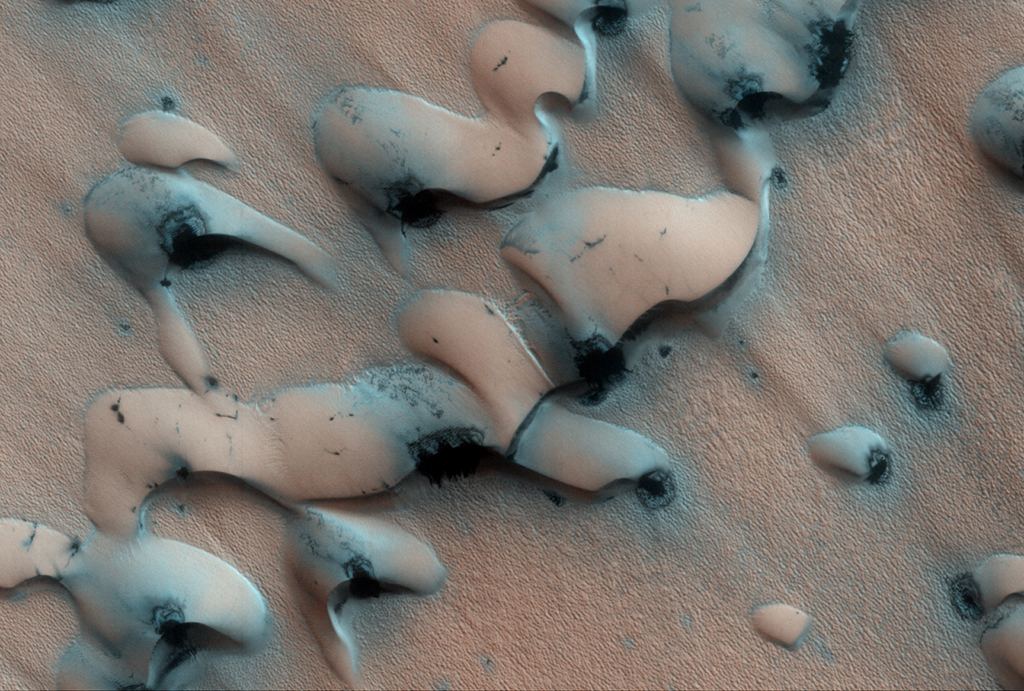In the 17th century, astronomers Giovanni Domenica Cassini and Christian Huygens noted the presence of hazy white caps while studying the Martian polar regions. These findings confirmed that Mars had ice caps in both polar regions, similar to Earth. By the 18th century, astronomers began to notice how the size of these poles varied depending on where Mars was in its orbital cycle. Along with discovering that Mars' axis was tilted like Earth's, astronomers realized that Mars' polar ice caps underwent seasonal changes, much like Earth's.
While scientists have been aware that Mars' polar ice caps change with the seasons, it has only been within the last 50 years that they have realized that they are largely composed of frozen carbon dioxide (aka. "dry ice") that cycles in and out of the atmosphere - and questions as to how this happens remain. In a recent study, a team of researchers led by the Planetary Science Institute (PSI) synthesized decades of research with more recent observations of the poles. From this, they determined how the Martian poles differ in terms of their seasonal accumulation and release of atmospheric carbon dioxide.
The team was led by Dr. Candice Hansen, a Senior Scientist with the Planetary Science Institute (PSI) and a member of the HiRISE imaging team. She was joined by researchers from the Lunar and Planetary Laboratory (LPL) at the University of Arizona, the University of Nevada, the U.S. Geological Survey's Astrogeology Science Center (USG-ASC), the Laboratory for Atmospheric and Space Physics at UC Boulder, IUCLA, the Astrophysics Research Centre at Queen's University Belfast, the German Aerospace Center (DLR), and NASA's Jet Propulsion Laboratory. The paper that details their findings recently appeared in the journal Icarus.
For their study, Hansen and her colleagues relied on data acquired by Mars orbiters over the past few decades. They then compared this with more recent data from the High-Resolution Imaging Experiment (HiRISE) instrument on the Mars Reconnaissance Orbiter (MRO). This allowed them to track the growth and recession of the Martian ice caps, which cycle about a quarter of the planet's atmosphere throughout a Martian year. The ultimate purpose was to learn more about the processes that shape the planet's surface and overall environment. As Hansen summarized in a PSI press release:
"Everybody knows there's a difference in how carbon dioxide interacts with the poles, but how many people understand why? That was what I was setting out to describe. And fortunately, I have a whole bunch of really talented co-authors who were willing to fill in their own pieces."
Like Earth, Mars experiences seasonal changes due to its axial tilt, about 25 degrees relative to the orbital plane, compared to Earth's tilt of about 23.5 degrees. But since Mars has a much longer orbital period (~687 days), the seasons last about twice as long as they do here on Earth. In addition, Mars has a greater orbital eccentricity - about 9% compared to 1.7% - which means its orbit is more elliptical. Because of this, Mars is farthest from the Sun when its northern hemisphere experiences Spring and Summer, while the south experiences Fall and Winter.
This means that summer in the southern hemisphere is shorter (while winter is longer in the north), coinciding with the dust storm season. As a result, the northern polar seasonal cap contains a higher concentration of dust than the south polar cap. "So ultimately, southern fall and winter bring the most freezing and lowest atmospheric pressure since so much of the atmosphere is frozen as dry ice," said Hansen. "These are the major drivers of differences in seasonal behavior of carbon dioxide between the hemispheres. They're not symmetric seasons."
There are also significant differences in terms of elevation between the northern and southern hemispheres—i.e., the Northern Lowlands and Southern Highlands. Differences between the northern and southern polar terrain also influence seasonal change. For example, black dust fans are distributed across the southern landscape, resulting from dry ice sublimating and causing dust plumes. As Hansen explained:
"A layer of carbon dioxide ice builds in the southern hemisphere fall, and over the course of the winter, it thickens and it becomes translucent. Then in the spring, the sun comes up, and light penetrates this ice layer to the bottom enough that it warms up the ground underneath. Now, gas is trapped under pressure. It's going to look for any weak spot in the ice and rupture like a champagne cork."
Once the gas finds a weak spot and ruptures the ice, it blows dark plumes of dust into the atmosphere. The dust is blown in different directions depending on the wind direction and lands in fan-shaped deposits. This process shapes the landscape by creating gully channels, colloquially called "spiders" (araneiforms) because of their arachnid-like appearance. While the northern hemisphere also experiences dust plums in the Spring, the relatively flat terrain causes them to form dune-like features. Said Hansen:
"When the Sun comes up and begins to sublimate the bottom of the ice layer, there are three weak spots – one at the crest of the dune, one at the bottom of the dune where it meets the surface and then the ice itself can crack along the slope. No araneiform terrain has been detected in the north because although shallow furrows develop, the wind smooths the sand on the dunes."
These findings demonstrate that Mars is an active place, not only over the course of eons but on a seasonal and even daily basis.
Further Reading: PSI*, Icarus*
 Universe Today
Universe Today


